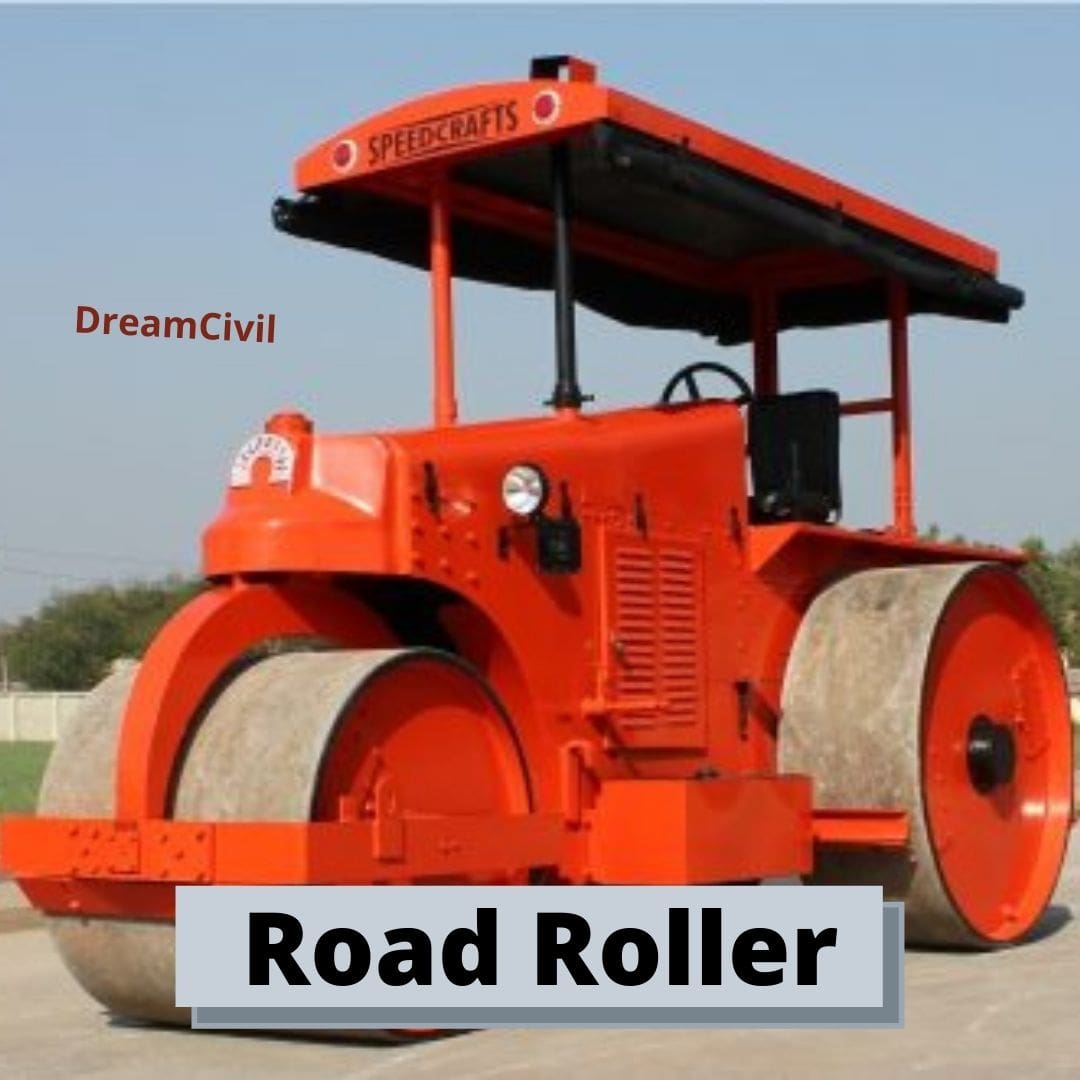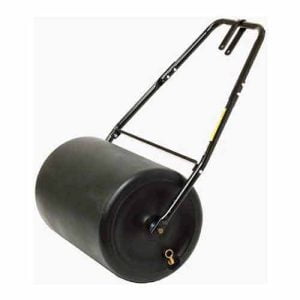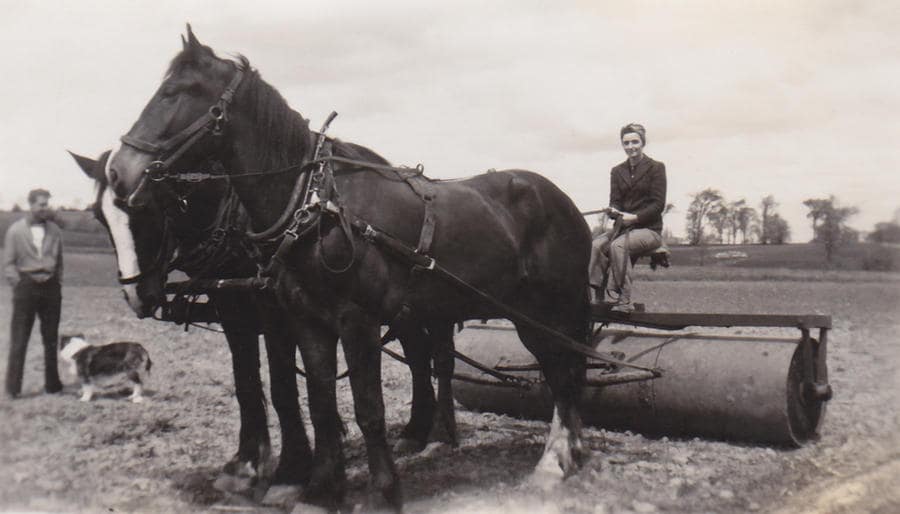Table of Contents
A road roller is a compactor-type engineering vehicle that was first invented by Alois Hamm and is utilized to compress soil, gravel, asphalt, and concrete for the construction of roads and foundation beds.
Firstly horses were used to drag the drum to fulfil the requirement of the roller, later a steam-powered engine was used. Eventually, the steam-powered engine was replaced by other sources like diesel or petrol-powered engines.

Road rollers can weigh around 1-20 tons.
The main purpose of road roller is to remove the voids present in the soil, gravel, or concrete making them solid, stable, and dense.
Heavier the roller, and compression will be successful.
It contains various components like a diesel engine, a cover to protect the driver, a drum ( vibratory smooth drum or statics smooth drum), a water system, tires, and a compaction meter to consider the compaction level.
| Single Drum Roller | Double Drum Roller | Triple Drum Roller |
| It contains only one drum at the front with wheels on the back. | It has 2 drums without wheels. | It has 3 drums without wheels. |
| It can move faster. | Comparatively, it moves slowly. | It is slower. |
| It is lighter. | It is heavier. | It is heavier. |
| It has more traction and mobility. | It has less traction and mobility. | It has lesser traction. |
2. Types of Road Roller
There are 6 types of road rollers which are explained below.
a. Grid Roller
The grid roller has a grid-like pattern in the steel drum.
It is generally towed behind the tractor or other heavy machines.

The grid may be ballasted with a concrete block or steel attachment for more contact pressure.
It provides low-kneading action.
It is not best for clayey soil, silty clay, uniform soils, etc.
It can be operated at a speed of 5-24km/hr.
This roller type contains steel bars placed in a grid pattern on the drum that serves a high-contact pressure to the soil. Because of this design, these machines are well suitable for compressing coarse soil and working on the subgrade and sub-base road construction projects.
Grid rollers are made of a cylindrical heavy steel surface comprising a network of steel bars which form a grid with square-shaped holes.
It is normal for the roller to be ballasted with concrete blocks. This type of roller is normally a pulling unit and serves a high contact pressure but minimum kneading action.
Uses: Compaction of well-graded coarse soils and weathered rocks.
b. Smooth Wheeled Rollers
It is also known as a Static Roller.
Its total weight is about 8-10 tons but the weight can be added by ballasting the inside space of the roller drum with water or wet sand.
It serves 100% ground coverage
It is of 2 types:
I. Three-wheeled Roller
This roller contains 2 wheels at the rear and 1 wheel at the front. Three-wheel road roller has bigger and heavier rolling drums prepared to give a better performance during the process of compacting.
II. Tandem Roller / Double drum Roller
This roller has 1 wheel at the front and 1 at the rear. The tandem, or double drum roller, has one steel drum in the front and one in the back.
As the two drums proceed, this also proceeds the roller. The efficiency of the tandem roller results from the two drums whole sections of a highway can be flattened and paved rapidly and efficiently.

It is useful when the material does not need high pressure.
Uses: large and gradual surface like asphalt, finish the top layer, etc.
Pros: flatten and pave the whole section rapidly and successfully.
2.3 Pneumatic Tyred Roller
The pneumatic roller is a type of road roller that is made of a heavily loaded wagon with many rows of 4 to 6 closely spaced tires.
It provides uniform pressure throughout the width with an 80% coverage area.
The pneumatic roller is also known as a rubber-tired roller.
The weight and air pressure of the tires can be placed to meet the desired certain pressure on a site.
They are mainly utilized for pavements and can help smooth out and polish a pavement, but are also best for cold-laid bituminous or cold mixed pavements and layers of loose soil.

The tire pressure is approximately 7kg/cm².
It provides better static penetration into the materials.
Rolling non-plastic silt and silty soils. Intermediate rolling of asphaltic concrete.
These rollers are used for the compaction of coarse-grained soils with some fines. The total weight of the roller can rise from 11.0 tonnes to 25.0 tonnes or more by ballasting with steel sections or other ways.
Uses: This roller is mainly used for pavement, soft base coarse material, layers of loose soil, cold laid bituminous and asphalt, etc
2.4 Sheepsfoot Roller/Tamping Roller/ Padfoot Roller
Sheepsfoot roller is a type of static or vibration type roller with round and rectangular lumps known as “lugs” and “feet” fixed on it. Sheepsfoot roller is also known as Padfoot or tamping rollers. They’re one of the best for compacting soil and silty clay in the field of road construction work
The lugs that are fixed on the drum are :
I. Spindle-shaped broad base
II. Clubfoot type
III. Prismatic type
The area of lugs or feet may vary from 30 to 80 cm².
Its coverage area is about 8% to 12%.
In wet conditions, the Tamping roller is utilized mostly. The layer thickness of the compacting soil must not be below the minimum of 50mm, which depends on the length of the foot. This is one of the main disadvantages of sheep foot rollers.

It is mainly utilized for the compaction of cohesive soil ( i.e, heavy clay, silty clay).
The drum weight can be increased either by ballasting with water, or damp sand or by mounting a steel section.
a. Has a steel drum fitted with ‘feet’ of one type or another
For example, sheepsfoot, wedge foot, and pad foot
b. Compacting layer up to 250 mm
c. Normal compaction for clay, clayey gravel, and sandy clays
d. Poor performance on sandy gravels o Not suitable for compact sand.
Uses: compacting soil, silty or wet clay, embankment, and subgrade layer in pavement, road, and railway projects.
2.5 Cylindrical Roller
A cylindrical roller is a traditional type of roller that is lightweight.
It is a type of walk-behind roller, typically drawn by hand and sometimes powered by an engine.

It is about 1 meter in diameter and 1.5 meters in length and is made up of iron, stone, or concrete.
The ground pressure induced by this type of roller is about 7kg/cm^2.
Uses: Mainly used for private projects, yard work, etc.
2.6 Vibratory Roller
The vibratory roller is similar to a smooth-wheeled roller with a steel drum of 0.9-1.5 meters in diameter and 1.2-1.8 meters in width.
It comes at a higher cost.

The drum imparts vibration by the rotation of an eccentric shaft inside.
A vibratory roller is a compactor having a drum utilized to densify soil, asphalt, or other materials through the use of combined static and dynamic forces to raise the load-bearing capacity of the surface. Vibratory rollers can totally cover the area below the wheel.
Just depending on static force (weight of the drums), a vibratory roller employs vibrating force to perform a more powerful effect. A rotating or reciprocating mass permits the drums to vibrate. The insertion of the vibrating force permits better work and higher compaction levels.
Uses: compacting granular base course, asphalt, crushed rock, and gravel and mostly for compacting in higher depths.
3. History of Road Roller
The first roller was horse-drawn and probably borrowed farm implements.
Since the usefulness of a roller varies to a large extent on its weight, self-powered vehicles put back horse-drawn rollers from the mid-19th century. The first such vehicles were steamrollers.
Single-cylinder steam rollers were majorly employed for base compaction and run with high engine revs with low gearing to advance bounce and vibration from the crankshaft through to the rolls in much the same manner as a vibrating roller.

The double cylinder or compound steam rollers started popular from around 1910 onwards and were used majorly for the rolling of hot-laid surfaces due to their smoother running engines, but both cylinder types are efficient in rolling the finished surface.
Steam rollers were usually dedicated to work by their gearing as the slower engines were for base compaction whereas the higher geared models were usually referred to as “chip chasers” which tracked the hot tar and chip laying machines. Some road companies in the US employed steamrollers through the 1950s.
In the UK some remained in service until the early 1970s. As internal combustion engines enhanced during the 20th century, kerosene-, gasoline- (petrol), and diesel-powered rollers slowly changed their steam-powered counterparts.
The first internal-combustion-powered road rollers were similar to the steam rollers they are changed. They used a similar method to transfer power from the engine to the wheels, typically large, exposed spur gears.
Some users opposed them in their infancy, as the engines of the era were generally hard to begin, particularly the kerosene-powered ones. Virtually all road rollers in service today employ diesel power.
4. Manufacturers
ABG (Germany) – SD/TD (purchased by Ingersoll Rand and now part of Volvo CE)
Albaret (France) – PT/TD (now part of Caterpillar)
Ammann Group (Switzerland)
Aveling-Barford (England) – TD/PT/3P
BOMAG (Germany) – SD/TD/PT (BOMAG/HYPAC in the USA market)
Case CE (USA) – SD (brands the Ammann/Sta machines as Case in the USA)
Caterpillar Inc. (USA) – SD/TD/PT (has the former lines of RAYGO, BROS and Bitelli)
Dynapac (Sweden) – SD/TD/PT/3P
Galion (USA)-
Hamm AG (Germany) – SD/TD/PT/3P (now part of the Wirtgen Group)
HEPCO (Iran) – SD/TD/PT/3P
Hitachi (Japan) – SD/TD/PT/3P
Huber Company, (USA)
Hyster (USA) – SD/TD/PT (part of HYPAC and Bomag USA)
Ingersoll Rand (USA) – SD/TD/PT (now owned by Volvo)
Kamani Engineering Corporation (India) – tractor-mounted (now part of the RPG Group; production ended c.1970-1980)
LiuGong, HQ at Liuzhou, China
Marshall (England) – TD
Sakai Heavy Industries (Japan) – SD/TD/PT/3P
Sany (China) – SD/TD/PT
World Equipment(China) – SD/TD/PT
Tampo (USA) – SD/TD
Vibromax (Germany) – SD/TD/PT (purchased by JCB, now branded JCB)
Wacker Neuson (Germany)
Note:
SD = Single drum
TD = Tandem drum
PT = Pneumatic tyre — Rubber tyres or multi-tyre are also common
3P = 3-point rollers — These are very similar to the old steam roller design
5. Advantages of Road Roller
The advantage of road roller is;
a. It is easy to handle and use.
b. It is safe and powerful.
c. It is easy to eyes and can work as we desired.
6. Disadvantage of Road roller
The disadvantage of road roller is;
a. They are costly.
b. Cause noise pollution.
| Read More: Excavator and its Type |
| Read More: Construction Tools List |

